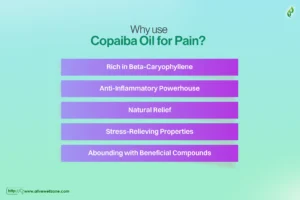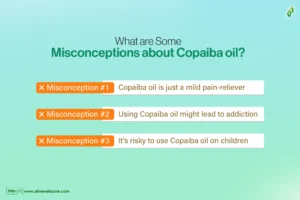
We all know how vast is the realm of natural remedies. Over time, essential oils have gained popularity, offering therapeutic benefits for a variety of ailments.
Among these, the powerful Copaiba oil has emerged as a sought-after solution for pain management. But the question on many minds remains: how to use copaiba oil for pain?
Well, if you have the same question, you’re in the right place. From here, we’ll explore this potent oil’s properties, dispel myths, and explain how it is used. Increasingly, people are looking for organic alternatives to synthetic pain relievers, such as Copaiba oil.
What is Copaiba Oil?
If you’ve never heard of Copaiba oil, you’re in for an enlightening treat. We’ll break it down for you so that you can easily get an idea.
Origin & Composition
Copaiba oil isn’t just from one source. It’s an exclusive blend derived from four different species, giving it a distinct edge in terms of health benefits.
Historical Significance
This isn’t a modern-day discovery. Copaiba oil has been the go-to remedy in South America for centuries, addressing a wide range of ailments.
Extraction Process
The oil comes from the balsamic resin of copaiba trees, mainly Copaifera officinalis and Copaifera langsdorffi, which are natives of the Amazon rainforest. These trees, with their towering presence, produce a sticky essence known as oleoresin.
It’s from this resin that the prized Copaiba essential oil is extracted.
Appearance
Though the resin may vary in colour, once the oil is extracted, it usually has a subtle pale yellow shade.
Applications
Beyond its medicinal properties, Copaiba oil is a favourite in the beauty world. You’ll often find it in —
- Soaps
- Creams
- Lotions
- Perfumes
It isn’t just an oil; it’s a testimony to nature’s profound ability to heal and beautify.
Chemical Properties of Copaiba
At first glance, diving into the chemical components of Copaiba oil might seem a tad technical, but bear with me. It’s going to get interesting!
Now, Central to Copaiba oil’s efficacy is its dominant component: beta-caryophyllene. This chemical bears a resemblance to cannabinoids, which might remind you of cannabis oil!
However, here’s where things get exciting —
No High with Copaiba
Despite having cannabinoid-like components, Copaiba doesn’t come with the psychoactive effects associated with cannabis. It carries the beneficial aspects without inducing the “high” sensation.
Receptor Insight
Our bodies house two main types of cannabinoid receptors: CB1 and CB2. While CB1 is responsible for marijuana’s euphoria, CB2 influences our immune system and nerve cells in a more subdued manner.
And guess what? Copaiba’s key constituent targets these CB2 receptors.
Benefits sans the Buzz
By binding with CB2 receptors, Copaiba oil plays a role in supporting a healthy nervous system and fortifying immune function. So, while you don’t get the psychoactive effects, the copaiba oil for nerve pain is potentially beneficial without the associated side effects.
On a side note, while many swear by the benefits, it’s essential to be mindful of any potential copaiba oil side effects
How to Use Copaiba Essential Oil
Essential oils can seem overwhelming, but understanding how to use copaiba oil for pain can be simplified into three primary methods: inhalation, topical application, and ingestion.

Inhalation
One of the most popular ways to enjoy the therapeutic benefits of copaiba oil is through inhalation. Simply place a few drops in a diffuser and let the soothing aroma permeate your surroundings.
It not only combats feelings of stress, anxiety, and depression but also fosters a serene and peaceful atmosphere. If you’re on the go, you can take a quick sniff directly from the bottle or place some in boiling water and breathe in the steam.
Topical Application
For skin-related issues like psoriasis, acne, and eczema, or if you want to learn about copaiba oil for nerve pain, a topical approach is recommended.
In that case, dab a cotton ball with Copaiba oil and gently pat the affected area after a skin-cleansing routine, which might involve steaming. However, ensure you know what to do after steaming your face.
In fact, regular application can pave the way for rejuvenated and glowing skin.
Ingestion
Hold on as this method requires a cautionary note. Look although copaiba oil is among the few essential oils deemed safe for consumption, it’s paramount to prioritize safety.
Plus, never ingest any essential oil without the guidance of a trained professional. If you decide to explore this avenue, make sure to opt for the purest therapeutic-grade essential oils.
Also, incorporate a few drops into an empty capsule, mix with tea, or sprinkle over food. However, a direct drop on the tongue might be too intense due to the concentrated nature of essential oils.
Remember to always do your research and consider checking copaiba oil testimonials for personal experiences.
Why use Copaiba Oil for Pain?
Ever wondered what makes Copaiba oil such a sought-after remedy for pain? Well, let’s delve into the heart of Copaiba to know the noteworthy reasons.

Rich in Beta-Caryophyllene
At the core of Copaiba oil lies its major component: beta-caryophyllene (β-caryophyllene). It isn’t just an ordinary ingredient; it’s known for its analgesic properties, acting as a natural painkiller.
But that’s not all, it also boosts cardiovascular health and fortifies the immune system.
Anti-Inflammatory Powerhouse
Inflammation is the culprit behind myriad discomforts – think arthritis, muscle spasms, and more. With its potent anti-inflammatory attributes, beta-caryophyllene in Copaiba provides a soothing balm to these inflammations.
Natural Relief
Unlike marijuana (rich in beta-caryophyllene), Copaiba ensures you reap the pain-relieving benefits without any mind-altering side effects. For those seeking alternatives, it makes it a preferred choice over other natural remedies like CBD oil.
Aside from Copaiba oil’s pain-relieving properties, essential oils offer a variety of health benefits. When it comes to hormone-balancing essential oils, understanding where to apply essential oils for hormone balance is pivotal.
Stress-Relieving Properties
Life’s stressors can amplify our perception of pain. Besides alleviating physical discomfort, beta-caryophyllene helps us stay calmer, and more balanced when we’re exposed to stressors.
Abounding with Beneficial Compounds
Copaiba oil is a treasure trove of health-enhancing compounds. Among them is humulene, vital for wound healing. Then there’s copaene, an antioxidant that doubles up as a fierce fighter against harmful microorganisms.

What are Some Misconceptions about Copaiba oil?
As with any natural remedy, there are myths that circulate, creating confusion for potential users. Let’s clear the air about Copaiba oil by addressing some prevalent misconceptions —
Misconception #1: Copaiba oil is just a mild pain-reliever.
Truth: Contrary to this belief, Copaiba oil is versatile in its pain-relieving properties. It can effectively alleviate both subtle discomforts and more severe chronic pains, tackling issues like fibromyalgia, arthritis, and neuropathy.
Misconception #2: Using Copaiba oil might lead to addiction.
Truth: Rest easy; Copaiba oil isn’t habit-forming. Unlike some pain medications that contain mind-altering compounds, it’s free from addictive substances.
Misconception #3: It’s risky to use Copaiba oil on children.
Truth: When used appropriately, Copaiba oil is child-friendly. For topical application, ensure it’s correctly diluted. However, always exercise caution. It’s not recommended for ingestion by children or for external use on infants under six months.
Safety With Copaiba Essential Oil
Follow these guidelines to keep yourself and your family safe while using copaiba oil —
- Always read labels and follow instructions.
- Seek advice from a healthcare professional before use.
- Dilute in a carrier oil before application.
- Avoid sensitive areas, like eyes and nose.
- Never apply to broken skin unless labelled safe.
- Store away from children and pets.
- If irritation (redness, itchiness, swelling) occurs, cease use and seek medical advice.
- Consult a healthcare provider before ingesting.
Wrapping Up
We’ve discussed misconceptions and understood Copaiba oil’s chemical composition. And most importantly, we’ve answered the pivotal question: how to use copaiba oil for pain.
Due to its unique compounds like beta-caryophyllene, it can soothe pain, inflammation, and various skin conditions organically. However, remember to consult a healthcare professional before applying or taking Copaiba oil as part of your wellness regime.
With the right knowledge, you can use Copaiba oil to its full potential for holistic health and well-being.






